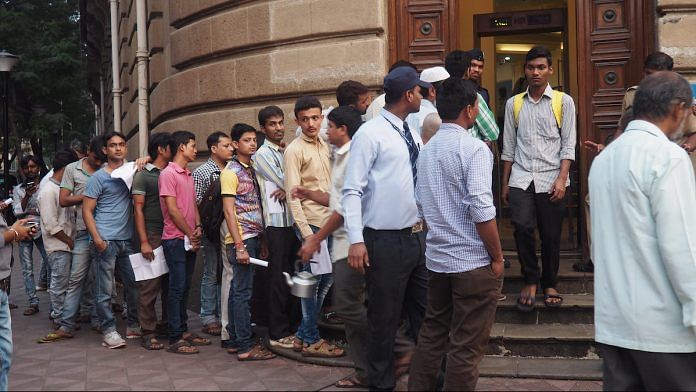New Delhi: A Supreme Court (SC) bench of five judges Monday upheld by 4:1 majority the Narendra Modi government’s November 2016 decision to ban Rs 500 and Rs 1,000 currency notes. The court held that the decision-making process on demonetisation did not suffer from any flaws.
The bench agreed with the central government’s submission that there was a “reasonable nexus between the measures undertaken and the object sought to be achieved” and, therefore, the demonetisation notification passed the test or doctrine of “proportionality”.
It even approved of the 52-day window fixed for the citizens to deposit the demonetised currency in banks and rejected the petitioners’ contention that the time period was a short one.
Further, the court also held that discussion preceded the final notification, hence, the decision-making process complied with statutory compulsions. It did not accept the petitioners’ contention that the RBI has independent power to accept demonetised notes after the window period is over.
The judgment came on a batch of nearly 58 petitions assailing the central government’s 2016 notification to ban Rs 500 and Rs 1,000 currency notes. Led by Justice S.A. Nazeer, the bench had reserved its verdict on 7 December after hearing elaborate arguments from the petitioners as well as the government.
The five-judge bench was comprised of Justices S. Abdul Nazeer, B.R. Gavai, A.S. Bopanna, V. Ramasubramanian, and B.V. Nagarathna. The majority judgment was authored by Gavai.
The sole dissenting judge, Nagarathna, differed with the majority view.
“Demonetisation at the behest of Centre is far more serious issue affecting citizens than the one done by the banks. Therefore, in my view, powers being vast of Centre, same has to be by plenary legislation,” she held.
According to her, when demonetisation originates from the central government and is not under section 26(2) of the RBI Act, or not on the central bank’s recommendation, then the legislative route is the legal exercise for the same. And if secrecy is needed then “ordinance is the way”.
She opined that the majority view does not recognise the essential fact that Section 26(2) does not take into account the initiation of demonetisation.
“Without parliament a democracy cannot thrive and so that meaning to democracy is given. Parliament cannot be left aloof on such important decisions,” she said.
To examine whether Section 26(2) was duly followed “would not mean to sit over the merits of demonetisation and thus it is well within the lakshman rekha as drawn by this court,” she held.
The RBI, she added, should “initiate the demonetisation process and not the Centre, and as this was reversed in 2016, the demonetisation decision was legally flawed.
She, however, did not doubt the “well-intended objective” of the notification, which was to “combat depraved practices of black money, terror funding and other such practices”.
She did not reverse the decision saying it took place six years ago.
The petitioners had contended the demonetisation decision was arbitrary and unconstitutional and contrary to the powers and the procedure prescribed under the Reserve Bank of India (RBI) Act.
The main premise on which the petitioners based their case was that the government did not follow the due procedure provided under the RBI Act before undertaking the massive exercise of withdrawing over 86 per cent of currency from circulation on 8 November, 2016.
The Modi government, however, claimed that it undertook demonetisation under section 26(2) of the RBI Act 1934 — a provision that empowers the government to declare that “any series of bank notes of any denomination shall cease to be legal tender” after a recommendation from the central board of RBI.
Among the three dozen petitioners challenging the 2016 notification are those who could not deposit their old currency by 30 December — the window period.
During the hearing, the court also directed the Ministry of Finance and the RBI to produce the relevant files leading to the decision.
Also Read: ‘Increased digital payments, pushed growth’: How govt defended demonetisation policy before SC
‘Mockery of the law’
In their petition before the court, petitioners called demonetisation “deeply flawed” and said it was the “worse-decision making” process that had made a “mockery of the rule of law”.
Petitioners told the court it was important to review the documents to assess if RBI had considered the impact of the withdrawal of such a large volume of currency which, in their opinion, had caused “agony, loss, and hardship” to the citizens.
Of the Rs 17.97 lakh crore currency that was in circulation in the market at that time, the demonetised currency notes were valued at Rs 15.44 lakh crore. Of this, Rs 15.31 lakh crore of the banned notes were returned to banks.
The petition also compared the 2016 exercise to the demonetisation exercises of 1946 and 1978. The value of the demonetised currency was only 11.5 per cent in 1946 and 0.6 per cent in 1978, the petition said. Therefore, the two instances of demonetisation did not impact the public or cause any hardships.
By comparison, the value of demonetised currency in 2016 was as high as 86.4 per cent of the currency in circulation, causing extreme hardships to the people, the petition said.
On its part, the central government justified the demonetisation exercise by invoking the “larger public interest” doctrine. In its arguments, the Modi dispensation told the court that the decision was taken to “rid the economy of black money, fake currency and terror financing”.
In addition, the government said, the move increased digital transactions and boosted compliance with income tax law.
It also claimed that demonetisation’s impact on the economy was “transient”. The real growth rate, the government argued, was 8.2 per cent in the 2016-17 financial year and 6.8 per cent in 2017-18 — more than the decadal growth rate of 6.6 per cent in the pre-pandemic years.
(Edited by Uttara Ramaswamy)
Also Read: Value of notes in use more than doubled in 6 yrs post demonetisation, Sitharaman tells Parliament



